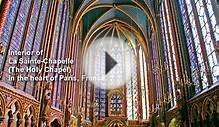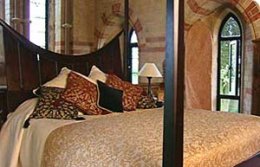
In this article
In the late 18th century aspects of the style were used for interiors and known as 'Gothick', along with rococo and chinoiserie, but in a romantic, frivolous way with no real historical basis.
The Victorians revived the style again in the mid-19th century but this time it was a reaction against classical style and its symmetry. It was also historically accurate. The style began principally in churches and public buildings but by the 1860s it influenced even domestic interiors.
Style
- ecclesiastical details - pointed arches, ogee arches, stained glass
- red and blue, gold
- 'tracery' - decorative ribbing
- heraldic emblems - coats of arms, mythical beasts and the tree of life
- 'cusping' - decorative projections of heads, gargoyles, animals or leaves
Influences
- medieval ecclesiastical architecture - churches and cathedrals
- illustrated medieval manuscripts
The names
- AWN Pugin - leader of Gothic revival, he designed interiors and the exterior detailing of the Houses of Parliament and Big Ben's clock tower (the Houses themselves were designed by Sir Charles Barry)
- George Gilbert Scott - architect of The Albert Memorial, Midland Grand Hotel at St Pancras station, London
- William Burges - architect of Cardiff Castle
- Herbert Minton - a potter who collaborated with Pugin on tiles
At the time
- 1843 A Christmas Carol is written by Charles Dickens
- 1847 Emily Bronte writes Wuthering Heights
- 1865 Louis Pasteur's 'germ theory'
- 1865 slavery is abolished
- 1866 dynamite is invented by Alfred Nobel
Get the look
- Beams - if you already live in a property with exposed wooden beams, you're halfway there for that medieval baronial style look. The Victorians added fake beams.
- Fireplaces - are large and imposing and usually made of stone (limestone) or elaborately carved wood. Choose a surround which has a pointed arch shaped inside surround.
- Lighting - tried to emulate the candlelight of authentic medieval ages. Look for huge metalwork chandeliers in black wrought iron and wall sconces in wrought iron and brass.
- Cornices - elaborately carved with tracery (ribbing) and latticework or ogee shapes.
- Walls - paint in stone colours either flat, or to resemble stone with a paint effect. Create recesses or niches in your walls and give them the pointed arch shape. Hang a medieval style tapestry on your wall attached with simple wooden battens.
- Wallpaper - ornate, typically red and gold, and heavily patterned. Look for naturalistically depicted flowers and foliage, stencilled lattice or trelliswork, coats of arms and fleur-de-lys. To get the effect of powdered ornament (evenly spaced motifs) make a stencil from acetate and stamp on your design with gold metallic paint. Alternatively, buy a stamp of your chosen design.
- Flooring - choose from large flagstones or fake the effect with clever stone blocking, which is a paint technique. Floorboards can be stained a dark oak colour with woodstain.
- Furniture - visit salvage yards and pick up old church furniture such as pews and lecterns. To guarantee the pieces have been obtained legally, check the yard is a member of Salvo. Choose chairs and screens in designs with pointed arches.
- Furniture - buy sturdy, hefty furniture such as huge oak dining tables and chairs with barley-twist legs.
- Stained glass - an important part of Gothic style because of its church connotations. Have panels commissioned, or make them yourself. Fake the effect with coloured acetates and gels (the kind the film industry uses). Cut out quatrefoils with a scalpel knife.
- Accessorise - with pewter plates and tankards, and suits of armour. Cover every available surface with ornaments and particularly stuffed animals in glass domes, place pairs of porcelain dogs at either end of the crowded mantelpiece.
What to invest in
- furniture from the Victorian Gothic revival period c.1840 to 1870 such as Gillows of Lancaster and Joseph Meeks & Son of New York.
- porcelain by Jacob Petit Factory, Paris.
Gothic:
- Notre Dame, Paris
- Wells Cathedral, Somerset
- King's College Chapel, Cambridge
Gothic revival:
- House of Parliament, rebuilt in Gothic style in 1836
- Cecil Higgins Museum, Bedfordshire. William Burges Room
- Eastnor Castle, Herefordshire
Further reading
- Victorian Gothic Style by Linda Osband (David & Charles)
- Gothic Revival by Megan Aldrich (Phaidon Press)
Source: www.bbc.co.uk
RELATED VIDEO

Urban Exploration: Gothic Revival Style Abandoned Farm House

Gothic House Tutorial

Beautiful Gothic Architecture


 The Confederate Powderworks (aka the Augusta Powderworks) was a gunpowder factory during the American Civil War, the only permanent structures completed by the Confederate States of America. Colonel G.W. Rains chose the old United States Arsenal site between the...
The Confederate Powderworks (aka the Augusta Powderworks) was a gunpowder factory during the American Civil War, the only permanent structures completed by the Confederate States of America. Colonel G.W. Rains chose the old United States Arsenal site between the...








